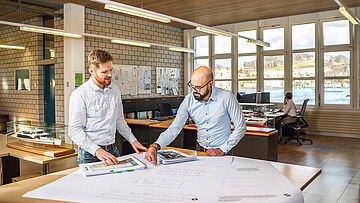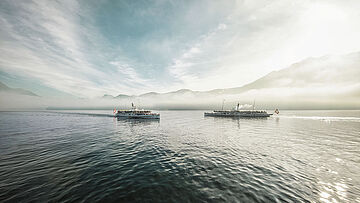
MS Jungfrau - Installation of new engines
Hybrid energy and drive system
Goals
Important to reduce fuel consumption and to therefore lower CO2emissions. The system should also be able to handle conversion to a genuinely sustainable energy supply in the future.
At the heart of the new drive system are two new electric motors that draw power from two different energy sources: from diesel generators or from a battery. The electric motors mostly draw their power from the three newly installed diesel generators. However, the MS Jungfrau can now temporarily operate in electric mode. Power is then supplied exclusively by the 2.2 tonne battery. The diesel generators are switched off. In the future, the Jungfrau will probably be able to glide silently over the lake for up to 30 minutes. If the battery runs down, it is charged up by the generators during the journey or can be connected to the power supply on the jetties.
Needs-based power production saves energy: With the new drive system, power will be produced as needed in the future. If the ship moves slowly and requires little energy, only one diesel generator is in operation. If the ship moves quickly and the staff in the ship’s kitchen require lots of energy, all three generators will operate at the same time.
The newly motorised MS Jungfrau uses twelve percent less diesel. With an annual consumption of around 100,000 litres on average, this saves 12,000 litres of diesel. The ship emits 32,000 kilograms less CO2 – this corresponds to the annual CO2emissions of over 15 cars. Another advantage of installing new engines is the interchangeability of the energy sources: The diesel generators that supply electricity to the electric motors today can be replaced by more environmentally friendly technologies such as solar panels or hydrogen once the technologies are established for use in inland water transport.
The installation of new engines cost around 1.7 million Swiss francs. By modernising the MS Jungfrau, BLS Schifffahrt has reached an important milestone in the modernisation of its fleet.




![[Translate to Englisch:] [Translate to Englisch:]](/assets/_processed_/b/f/csm_image00016_dbc085d159.jpeg)
![[Translate to Englisch:] [Translate to Englisch:]](/assets/_processed_/6/2/csm_Anfahrten_14f1c9565f.jpg)
![[Translate to Englisch:] [Translate to Englisch:]](/assets/_processed_/1/1/csm_Dashboard1_20ebb3e39a.jpg)
![[Translate to Englisch:] [Translate to Englisch:]](/assets/_processed_/8/8/csm_IMG_4354_6eb179754f.jpg)



